|
|
|
| Selected
Article |
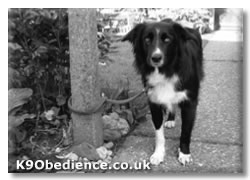 This is an idea which can work wonders with dogs which ‘won’t’ (have not been trained to) obey commands at a distance from their owner. Many dogs will only ever obey a command if they are facing their owner and are less than six feet in front of them. This is because we usually start training This is an idea which can work wonders with dogs which ‘won’t’ (have not been trained to) obey commands at a distance from their owner. Many dogs will only ever obey a command if they are facing their owner and are less than six feet in front of them. This is because we usually start training
a) in the home (at close quarters) and
b) with food treats (also at close quarters so the dog can see and take the treat).
This means that very quickly the dog has been conditioned to a set of common factors as well as the command given by the owner. When we say “Sit!” the dog only fully understands what we mean if all of the other familiar things are in place such as the atmosphere, the location, the physical position of both dog and owner and various other things. Some dogs are more sensitive to environmental factors than others, but all dogs are aware of them to some degree.
In this case then, the environmental factor which we want to ‘train out’ of the dog is the distance from owner or person giving the command. 
When training your dog to perform any stationary action such as sit, down, stand etcetera, try putting his lead and collar on and clipping him to a fixed object like a post or tree. Through training the dog to sit at our feet or just in front of us using the lure of food or a toy what we have actually taught the dog is different to what we were trying to teach him and what we thought we had taught him. What we wanted him to learn was to sit every time we said “Sit”.
What we actually taught him is to come to within about six feet of us and to sit infront of us when he hears that command. Notice that when a dog is told to sit by its owner, it NEVER walks behind the owner and sits looking at his/her back! You may think it is strange that I should suggest such a silly idea but if you had rewarded the dog for doing this from day one then that is exactly what he would do. Instead we like to watch the dog so that we know when he sits and this makes us constantly turn to face the dog wherever he goes.
He also stays very close to us because we have something he wants like a biscuit and he is eager to get it. By clipping him to a post or something similar we make it impossible for the dog to move any closer to us. This is the first environmental change that the dog is going to experience during the sit command and it may cause some confusion and even minor distress, so you must keep calm and be careful not to expect too much the first time.
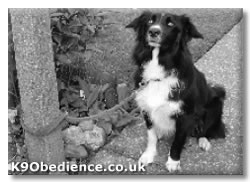 You can ask another person to hold the lead but this introduces another source of confusion for the dog and it is best to have a completely inanimate object anchoring him in position. You can ask another person to hold the lead but this introduces another source of confusion for the dog and it is best to have a completely inanimate object anchoring him in position.
The next thing to do is to stay very close to your dog and give him the sit command as you would normally. At this point what you should be trying to do is to exactly copy all the previous situations where you have trained him to sit. This probably means that you are close enough to stroke him on the top of his head. The only difference is the lead being attached to the post. You should completely ignore the lead so that he feels this is as normal as possible.
When he sits, treat him as usual whether that be a pat on the head, a treat or just “Good Boy”. Now move about six inches further away from him and repeat exactly the same procedure. Do it a couple of times at this distance.
If he is finding it difficult then don’t react in any way, simply go back close to him again and work more slowly and more gradually this time, maybe only moving a few inches away. It is all dependant on the dog but most people will find that within about ten minutes, if doing it correctly, you should be able to have the dog sitting for you when you stand about two or three feet away from him. Some dogs will be faster still at picking this up but there is no need to hurry.
The thing to remember is this: If you go too slowly, the dog will simply get bored and lose interest. If, however, you try to progress too quickly, you may well end up confusing the dog and it can take ten times as long to clear his mind of this confusion before you can start this again. The best thing is to try to find a balance which keeps the dog ‘working’ and ‘thinking’ but without over-stressing him.
 It is easy to find this balance when you know the signs to look out for. When I found out what these signs were, I was astounded at how easy it made training sessions compared to before. We will be featuring several articles specifically on this subject as it is essential for learning how to get your dog into the Perfect Training State. This is a state where he is keen to work for you, he wants to work out what you want and he is relaxed and happy enough to be able to concentrate fully on the task being set. It is easy to find this balance when you know the signs to look out for. When I found out what these signs were, I was astounded at how easy it made training sessions compared to before. We will be featuring several articles specifically on this subject as it is essential for learning how to get your dog into the Perfect Training State. This is a state where he is keen to work for you, he wants to work out what you want and he is relaxed and happy enough to be able to concentrate fully on the task being set.
We want the dog to be eager which is shown mainly by his stance, his tail, and his ears but you will probably already be able to recognise it just by looking into his eyes! It is that look he gives you when you pick up his lead or his food bowl! Yes you know the one I mean!
We also want the dog to be positively stressed which obviously is the opposite of negatively stressed although it can be a very thin line between the two.
Positive stress is shown by light panting, tail wagging and/or held high, and eyes focussed on you all the time. This can quickly turn into negative stress if you make the dog work too hard (mentally) or do too many things at once. The signs for when this has happened are heavy panting, yawning, tail stops wagging and hangs much lower, possibly under the stomach, and the eyes can begin to wander and look quite desperate. There are various other telltale signs but these are the most obvious ones. If you study your dog’s behaviour when training, and keep these in mind, you will very quickly develop an instinct for the level and type of stress he is showing.
So, each time you have sneaked a little further away from your dog, and he has sat on command, you treat him in the usual way. A small tip might be to increase the size of the treat the further away you go, although most people will do this anyway without realising due to their excitement increasing at seeing their dog learn. Alternatively you can use ‘shaping’. This is another subject which deserves a whole book to be written about it, never mind a small paragraph and we will be covering this in great detail in future articles.
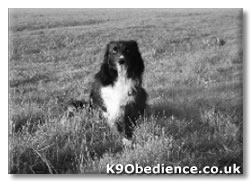 For now though, shaping is simply a method for fine-tuning a command already taught or for extending it into something else. In this case the way to use it would be to carry out all of the above as normal but when the dog is fully competent at sitting at least a short distance away from you, remove the lead and collar and do it with him running free. When he sits on command fairly close to you, a subtle “Good Boy!” will suffice just to let him know that what he did was correct and that you are pleased with him, but you are not going overboard. When he sits on command further away from you than he previously has, THEN you go overboard with treats or toys and shouts of joy etcetera. For now though, shaping is simply a method for fine-tuning a command already taught or for extending it into something else. In this case the way to use it would be to carry out all of the above as normal but when the dog is fully competent at sitting at least a short distance away from you, remove the lead and collar and do it with him running free. When he sits on command fairly close to you, a subtle “Good Boy!” will suffice just to let him know that what he did was correct and that you are pleased with him, but you are not going overboard. When he sits on command further away from you than he previously has, THEN you go overboard with treats or toys and shouts of joy etcetera.
Having calmed down and got back to work, you make a mental note of how far away he was the last time and you now ‘expect’ him to be able to do this. This means that if he sits at this distance now, you would only give him the “Good Boy!” and you will wait for him to sit at an even greater distance before again going overboard with rewards and excitement. This is not in any way meant to be a punishment for the dog not performing. It is positive training through the use of variable rewards, always saving the best reward or ‘jackpot’ for a definite and significant improvement or extension on the dog’s previous best effort. Using any form of punishment would only make it more difficult both for owner and dog. The “Sit!” command should have no stressful associations, this way the dog is relaxed enough and eager enough to concentrate on working out for himself what he has to do to earn that wonderful jackpot!
You may wish to introduce a visual command at this stage. If you are aiming to have your dog trained to sit at a great distance from you, then you should definitely consider this because, with a strong wind blowing straight onto your face, you may find it very difficult to shout the command loud enough for the dog to hear it. In such circumstances you should also be aware that the dog may not respond the same way and this may be due to the fact that another one of those ‘environmental factors’ has changed again. In this case it could be that, although you are pronouncing the same word of “Sit!”, the fact that you are shouting might make it sound completely different to the dog than it did before and therefore a hand signal (or other visual signal) can be a godsend, especially for the dog!
You can make the actual signal up yourself but I would suggest something like a hand held high above your head or out to the right, horizontal to the ground. Remember to keep the signal the same every time and produce it clearly and quickly.
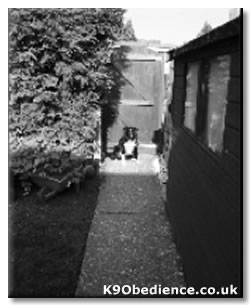 To introduce the signal to the dog you would simply show the signal at the same time as giving the “Sit!” command when you are certain that he will sit, i.e. when he is close to you. Now gradually increase the distance as before but a little more quickly. When he has learnt to obey the visual command and verbal command together, which should not take long, you should gradually reduce the emphasis on your voice and increase the emphasis on your hand signal. You can lower the volume of your voice slightly and you can offer the hand signal a bit earlier than the verbal command and within a few sessions you should be able to make him sit at a distance just using the visual commands. To introduce the signal to the dog you would simply show the signal at the same time as giving the “Sit!” command when you are certain that he will sit, i.e. when he is close to you. Now gradually increase the distance as before but a little more quickly. When he has learnt to obey the visual command and verbal command together, which should not take long, you should gradually reduce the emphasis on your voice and increase the emphasis on your hand signal. You can lower the volume of your voice slightly and you can offer the hand signal a bit earlier than the verbal command and within a few sessions you should be able to make him sit at a distance just using the visual commands.
This can be very exciting to those who have only ever used verbal commands. It is something to do with the fact that in complete silence, you can command the dog to do various things and this can appear incredibly impressive to onlookers and to yourself!
I actually find this is a very useful way of helping people who are having problems training their dogs. A very common cause of failure in dog training is a lack of clear understanding of the commands by the dog. The owners however are often adamant that the dog “knows exactly what to do and he is just being stubborn!” When I ask such owners to replace the old commands with these hand signals they then discover that the dog did not have a clue what they meant before as he does it every time now that they are keeping their mouths closed! 
The reason is simple, your voice can vary in a thousand ways and the dog can detect every single one of these variations. With your hands however, you either stick it out or you don’t. Although your physical enthusiasm, (or lack of), can show a little if you’re not careful, there is much less room for uncertainty and variation. It can therefore yield much better results and is great fun at the same time.
What is interesting to note is how much people use visual commands already without realising it. I would bet that if you took all the dogs in the UK who are trained to lay down on command and asked their owners to make them lay down while keeping their back straight, their head up, and their hands behind their backs (the owners that is!) over half of those dogs would not lie down. Of the other half that would lie down, I bet that most of them would only do so after some sort of delay or fidgeting beforehand, which is a sign of slight confusion or stress while the dog guesses what to do next.
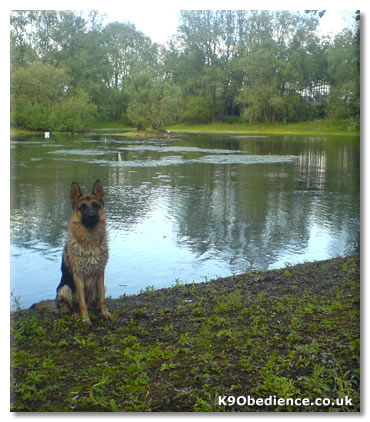
This is because nearly everybody I have ever seen giving the “Down!” command to their dog, does so with what they think is one command but what the dog knows is at least two. When they say “Down!” they either point to the floor, lean forwards towards the floor, look at the floor or any combination of these with many more besides. The voice often varies in pitch, volume, direction and emotional emphasis, but that little finger which you don’t even think about, just keeps pointing at the floor every time!
The dog, being the intelligent animal that he is, therefore sticks to the most consistent option which is usually the visual command. It is not a grave error by the owner. It is simply a psychological characteristic where, because we want him to lay down, our subconscious is thinking of the ground and so we point to it, look at it, and gesture towards it in various ways. To prove the dog often watches more than he listens, all you have to do is ask someone who shows these signals to try downing their dog without using their hands and body language and then to try it without using their voice. Without the voice wins every time!
If you try out any of these methods yourself, we would love to hear how you get on. Send us an email or visit the dog forum with any problems or breakthroughs you may have had. By sharing our information and your dog training experiences, we can all benefit and avoid
mistakes others may have made already. Not only does this make our training time more productive and much more fun, but it also helps our dogs learn, and this is always a worthwhile cause.

|
|
|
|
|
|





